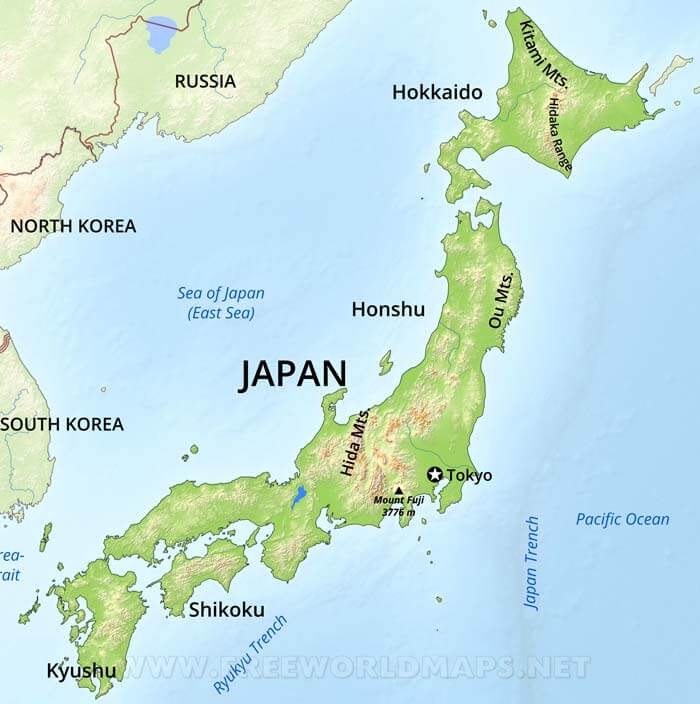Japan Information
Japan (Japanese: Nihon or Nippon) is an island country located on the Pacific Ocean, east of China and Korea, stretching from the Sea of Okhotsk in the north to Taiwan in the south. It is composed of over 3,000 islands, the largest of which are Hokkaido, Honshu, Shikoku, and Kyushu. Most of Japan’s islands are mountainous, and many are volcanic; the highest peak is Mount Fuji.
Japan is the third-largest economy in the world and one of the world’s leading industrialized countries. It is a unitary constitutional monarchy with an emperor and an elected parliament, one of the oldest legislatures in Asia. Despite its rugged terrain, it is one of the most populous and one of the most densely populated countries in the world. Its capital, Tokyo, is the largest metropolitan area in the world with over thirty million residents.
Historically, Japan adopted many Chinese customs and institutions beginning in the 7th and 8th centuries. From the 12th century to the mid-1800s, Japan was a feudal country led by clans of warriors. After the Meiji Restoration of 1868, Japan adopted many European and American customs and institutions. Its culture today is a mixture of these influences.
Japan’s name in Chinese characters is often translated as “Land of the Rising Sun“, and comes from the country’s location on the east coast of Asia . It is English name is derived from the Chinese name for Japan

| Capital | Tokyo |
| Largest city | Tokyo* |
| Official language(s) | Japanese |
| Government | Constitutional monarchy |
| Emperor | Akihito |
| Prime Minister | Yukio Hatoyama |
| Formation Emperor Jimmu Meiji Restoration Current constitution Treaty of San Francisco | 660 BC January 3,1868 May 3, 1947 April 28, 1952 |
| Area Total Water (%) | 377,835 km2 (63) 145,883 mi2 0.8% |
| Population 2005 est. Density | 127,417,244 (10th) 337/km2 (18th) 873/mi2 |
| GDP (PPP) Total Per Capita | 2005 estimate $3.867 trillion (3rd) $30,400 (12th) |
| HDI (2003) | 0.943 (11th) high |
| Currency | Yen (JPY) |
| Time zone Summer (DST) | JST (UTC+9) None (UTC) |
| Internet TLD | .jp |
| Calling code | +81 |
* Largest urban area. Yokohama is the largest incorporated city.
Geography
Japan, a country of islands, extends along the eastern or Pacific coast of Asia. The main islands, running from north to south, are Hokkaido, Honshu (or the mainland), Shikoku, and Kyushu. Naha in the Ryukyu archipelago is over 600 kilometres (375 mi) to the southwest of Kyushu. In addition, about 3,000 smaller islands may be counted in the full extent of the archipelago.
Japan is the 18th most densely populated country in the world. About 73% of the country is mountainous, and unsuitable for agricultural, industrial, or residential use, due to the generally steep elevations, climate, and risk of landslides caused by earthquakes, soft ground, and heavy rain. This has resulted in an extremely high population density in the habitable zones that are mainly located in coastal areas.
Its location on the Pacific Ring of Fire, at the juncture of three tectonic plates, gives Japan frequent low-intensity earth tremors and occasional volcanic activity. Destructive earthquakes, often resulting in tsunamis, occur several times each century. The most recent major quakes include the 2004 Chuetsu Earthquake and the Great Hanshin Earthquake of 1995. Hot springs are numerous, and have been developed as resorts.
The climate of Japan is predominantly temperate but varies greatly from north to south. Japan’s geographical features divide it into six principal climatic zones:
Hokkaido : The northernmost zone has a temperate climate with long, cold winters and cool summers. Precipitation is not heavy, but the islands usually develop deep snow banks in the winter.
Sea of Japan : On Honshu’s west coast, the northwest wind in the wintertime brings heavy snowfall. In the summer, the region is cooler than the Pacific area, though it sometimes experiences extremely hot temperatures, due to the Föhn wind phenomenon.
Central Highlands : A typical inland climate, with large temperature differences between summer and winter, and between day and night. Precipitation is light.
Seto Inland Sea : The mountains of the Chugoku and Shikoku regions shelter the region from the seasonal winds, bringing mild weather throughout the year.
Pacific Ocean : The east coast experiences cold winters with little snowfall and hot, humid summers due to the southeast seasonal wind.
Southwest Islands : The Ryukyu Islands have a subtropical climate, with warm winters and hot summers. Precipitation is very heavy, especially during the rainy season. Typhoons are common.
The main rainy season begins in early May in Okinawa, and the stationary rain front responsible for this gradually works its way north until it dissipates in northern Japan before reaching Hokkaido in late July. In most of Honshu, the rainy season begins before the middle of June and lasts about six weeks. In late summer and early autumn, typhoons often bring heavy rain.
Japan is home to nine forest ecoregions which reflect the climate and geography of the islands. They range from subtropical moist broadleaf forests in the Ryukyu and Bonin islands, to temperate broadleaf and mixed forests in the mild climate regions of the main islands, to temperate coniferous forests in the cold, winter portions of the northern islands.
